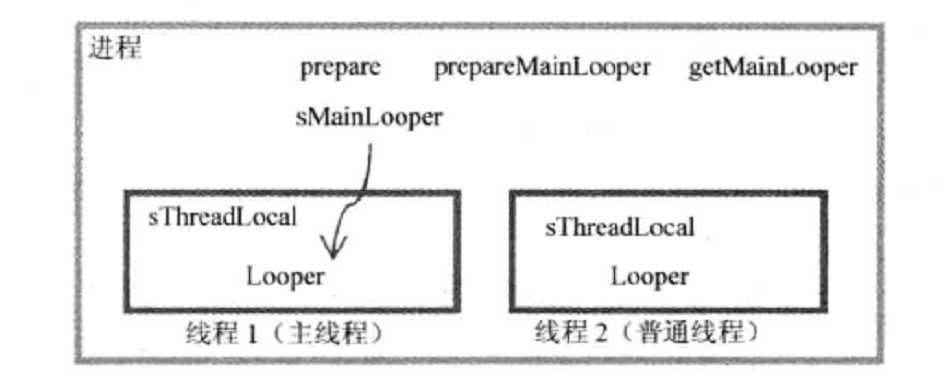标签:
一:android 进程和线程
进程是程序运行的一个实例。android通过4大主件,弱化了进程的概念,尤其是在app层面,基本不需要关系进程间的通信等问题。
但是程序的本质没有变,尤其是多任务系统,以事件为驱动的软件系统基本模式都是如下:
程序的入口一般是main:
1.初始化:
比如创建窗口,申请资源等。
2.进入while(true)
在循环中处理各种事件,直到进程退出。
四大组件是进程的部分载体,配置进程在androidmanifest.xml里面,android:process 属性。
当然默认所有的都在同一个进程里面,由application里面配置,默认进程为apk的包名。
线程是进程的有机组成部分,是CPU调度的基础。
一般情况下,都有主线程和其他线程之分,只有主线程才可以刷新UI。
应用程序启动后,将创建ActivityThread 主线程。
不同包名的组件可以一定的方式运行在同一个进程中。
一个Activity启动后,至少会有3个线程。一个主线程和2个binder线程。
二:android 进程内的消息驱动机制---Handler,MessageQueue,Runnable,Looper
1.Runnable & MessageQueue:
Runnable 和Message 是消息的2种载体。
消息的行为本质上就是 一段操作Runnable,或者是一段数据Message,包含这操作内容,由handlemessage来判断处理。
他们的操作方式就是:
public final boolean post(Runnable r)
{
return sendMessageDelayed(getPostMessage(r), 0);
}
public final boolean postAtTime(Runnable r, long uptimeMillis)
public final boolean postAtTime(Runnable r, Object token, long uptimeMillis)
上面就是Runnable的方法,可以看到Runnable会被分装成Message的形式发送。
private static Message getPostMessage(Runnable r) { Message m = Message.obtain(); m.callback = r; return m; }
所以本质上,都是以Message的封装方式处理。
最终所有的消息都会放入MessageQueue里面。
MessageQueue并不是一个真正的队列,而是链表。
Looper就是循环在某件事情,类似于while(true)干的事情。
Handler就是真正做事情的。
Looper不断的从MessageQueue从取出数据,然后交给handler来处理。
2.Handler:
framework/base/core/android/os/Handler.java
其实handler的作用,它的注释已经解释的非常清楚。
/** * A Handler allows you to send and process {@link Message} and Runnable * objects associated with a thread‘s {@link MessageQueue}. Each Handler * instance is associated with a single thread and that thread‘s message * queue. When you create a new Handler, it is bound to the thread / * message queue of the thread that is creating it -- from that point on, * it will deliver messages and runnables to that message queue and execute * them as they come out of the message queue. * * <p>There are two main uses for a Handler: (1) to schedule messages and * runnables to be executed as some point in the future; and (2) to enqueue * an action to be performed on a different thread than your own. * * <p>When posting or sending to a Handler, you can either * allow the item to be processed as soon as the message queue is ready * to do so, or specify a delay before it gets processed or absolute time for * it to be processed. The latter two allow you to implement timeouts, * ticks, and other timing-based behavior. */
这个一共三段内容,大意是:
1)handler使用runnable或者message的方式传递,存储在一个thread的messagequeue里面。
当你创建一个新的handler的时候,他会与这个创建它的线程绑定。
对于一个Thread 来说MessageQueue,和Looper只有一个。
2)使用handler一般有2种场景。
希望do runnable或者某种Message 在in the future.
或者把一个action(Runnable or Message)传递到其他线程进行操作。
常见的操作就是在工作线程中使用主线程handler来操作UI。
3)你可以让handler直接操作message内容,或者等待一段时间,这个时间是可以配置的。
handle的2大功能
处理message:
public void dispatchMessage(Message msg) 分发消息 public void handleMessage(Message msg) 处理消息,该方法通常情况下,须由子类继承。
Looper.loop()方法会调用dispatchMessage来处理消息。
public void dispatchMessage(Message msg) { if (msg.callback != null) { handleCallback(msg); } else { if (mCallback != null) { if (mCallback.handleMessage(msg)) { return; } } handleMessage(msg); } }
handler的子类通过重载该方法,可以修改handler的消息派发方式。
handler的第二个作用是把message & Runnable分装到MessageQueue里面。
handler,messagequeue,looper目的是什么,目的就是启动消息机制。
MessageQueue:
MessageQueue从哪里得到,从Handler源码看到,是从Looper里面来的。
public Handler(Looper looper, Callback callback, boolean async) { mLooper = looper; mQueue = looper.mQueue; mCallback = callback; mAsynchronous = async; }
Looper:
private Looper(boolean quitAllowed) { mQueue = new MessageQueue(quitAllowed); mThread = Thread.currentThread(); }
Looper 构造函数就干了2件事。
创建Messagequeue,所以 每个Looper都有唯一的一个MessageQueue与之对应。
得到运行thread。
// sThreadLocal.get() will return null unless you‘ve called prepare(). static final ThreadLocal<Looper> sThreadLocal = new ThreadLocal<Looper>();
Looper有个特殊的变量,ThreadLocal, 这个对象只对自己所在的线程全局,其他的线程无法看到它。
Looper提供了很多static的方法,所以肯定还有一些能都识别“身份“的方法。
这些方法在我们使用looper 的时候,最重要的是如下2个:
private static void prepare(boolean quitAllowed) { if (sThreadLocal.get() != null) { throw new RuntimeException("Only one Looper may be created per thread"); } sThreadLocal.set(new Looper(quitAllowed)); }
/** * Run the message queue in this thread. Be sure to call * {@link #quit()} to end the loop. */ public static void loop() { final Looper me = myLooper(); if (me == null) { throw new RuntimeException("No Looper; Looper.prepare() wasn‘t called on this thread."); } final MessageQueue queue = me.mQueue; // Make sure the identity of this thread is that of the local process, // and keep track of what that identity token actually is. Binder.clearCallingIdentity(); final long ident = Binder.clearCallingIdentity(); for (;;) { Message msg = queue.next(); // might block if (msg == null) { // No message indicates that the message queue is quitting. return; } // This must be in a local variable, in case a UI event sets the logger Printer logging = me.mLogging; if (logging != null) { logging.println(">>>>> Dispatching to " + msg.target + " " + msg.callback + ": " + msg.what); } msg.target.dispatchMessage(msg); if (logging != null) { logging.println("<<<<< Finished to " + msg.target + " " + msg.callback); } // Make sure that during the course of dispatching the // identity of the thread wasn‘t corrupted. final long newIdent = Binder.clearCallingIdentity(); if (ident != newIdent) { Log.wtf(TAG, "Thread identity changed from 0x" + Long.toHexString(ident) + " to 0x" + Long.toHexString(newIdent) + " while dispatching to " + msg.target.getClass().getName() + " " + msg.callback + " what=" + msg.what); } msg.recycle(); } }
prepare才是looper创建以及和thread绑定的地方。
looper.loop()方法是整个looper机制启动的地方。
从此thread就会接受消息和处理消息了。
这里有个小问题:
Message msg = queue.next(); // might block if (msg == null) { // No message indicates that the message queue is quitting. return; }
一开始的时候,MessageQueue handler没有传递消息进队列,按理说取到的消息是null,这样looper就直接退出了。
这个问题等到分析源码的时候,在解决。
这样handler,messaqequeue,looper, 和thread都关联起来了。
下面还有一个mainlooper的问题。
public static void main(String[] args) { ... Looper.prepareMainLooper(); if (sMainThreadHandler == null) { sMainThreadHandler = thread.getHandler(); } Looper.loop(); }
以上是ActivityThread的部分入口函数main的源码:
可见prepareMainLooper()的方法,是给主线程使用的。
而looper那边的
private static Looper sMainLooper; // guarded by Looper.class
是为了给其他线程应用使用。
这样其他线程可以给主线程发消息。

如图所示:主线程的looper将由sMainLooper作为应用,保存在static空间中,其他工作线程可以访问它
至此,整个消息机制的框架已经驱动起来。
标签:
原文地址:http://www.cnblogs.com/deman/p/4688054.html